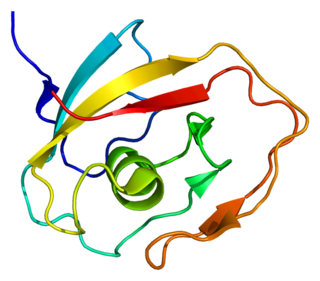
Collagen alpha-2(XI) chain is a protein that in humans is encoded by the COL11A2 gene.

Gap junction beta-2 protein (GJB2), also known as connexin 26 (Cx26) — is a protein that in humans is encoded by the GJB2 gene.

Wolframin is a protein that in humans is encoded by the WFS1 gene.

Eyes absent homolog 1 is a protein that in humans is encoded by the EYA1 gene.

Cochlin is a protein that in humans is encoded by the COCH gene. It is an extracellular matrix (ECM) protein highly abundant in the cochlea and vestibule of the inner ear, constituting the major non-collagen component of the ECM of the inner ear. The protein is highly conserved in human, mouse, and chicken, showing 94% and 79% amino acid identity of human to mouse and chicken sequences, respectively.

Gap junction beta-3 protein (GJB3), also known as connexin 31 (Cx31) — is a protein that in humans is encoded by the GJB3 gene.

Phosphorylase b kinase regulatory subunit alpha, liver isoform is an enzyme that in humans is encoded by the PHKA2 gene.

Potassium voltage-gated channel subfamily KQT member 4, also known as voltage-gated potassium channel subunit Kv7.4, is a protein that in humans is encoded by the KCNQ4 gene.

Alpha-tectorin is a protein that in humans is encoded by the TECTA gene.

Myosin-14 is a protein that in humans is encoded by the MYH14 gene.

Nucleoporin-like 2 is a protein that in humans is encoded by the NUPL2 gene.

Eyes absent homolog 4 is a protein that in humans is encoded by the EYA4 gene.

Otoferlin is a protein that in humans is encoded by the OTOF gene.

Coiled-coil domain-containing protein 50 is a protein that in humans is encoded by the CCDC50 gene.

Transmembrane channel-like protein 1 is a protein that in humans is encoded by the TMC1 gene. TMC1 contains six transmembrane domains with both the C and N termini on the endoplasmic side of the membrane, as well as a large loop between domains 4 and 5. This topology is similar to that of transient receptor potential channels (TRPs), a family of proteins involved in the perception of senses such as temperature, taste, pressure, and vision. TMC1 has been located in the post-natal mouse cochlea, and knockouts for TMC1 and TMC2 result in both auditory and vestibular deficits indicating TMC1 is a molecular part of auditory transduction.

Myosin-XV is a protein that in humans is encoded by the MYO15A gene.

Gap junction delta-2 protein (GJD2) also known as connexin-36 (Cx36) or gap junction alpha-9 protein (GJA9) is a protein that in humans is encoded by the GJD2 gene.

Vesicular glutamate transporter 3 (VGLUT3) is a protein that in humans is encoded by the SLC17A8 gene.

Otogelin is a protein that in humans is encoded by the OTOG gene.

Pejvakin is a protein that in humans is encoded by the PJVK gene.




















